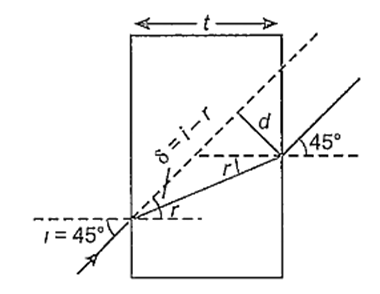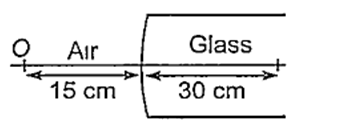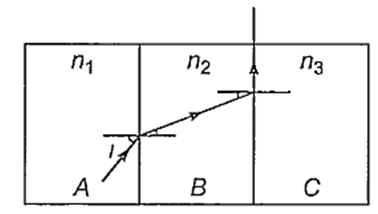 Multiple Choice Questions
Multiple Choice QuestionsA ray oflight is incident on a surface of glass slab at an angle 45°. If the lateral shift produced per unit thickness is m, the angle of refraction produced is
B.
Here, angle of incidence i = 45°

Two luminous point sources separated by a certain distance are at 10 km from an observer. If the aperture of his eye is 2.5 × 10-3 m and the wavelength of light used is 500 nm, the distance of separation between the point sources just seen to be resolved is
12.2 m
24.2 m
2.44 m
1.22 m
The angle of minimum deviation for an incident light ray on an equilateral prism is equal to its refracting angle. The refractive index of its material is
A parallel beam of light is incident on a converging lens parallel to its principal axis. As one moves away from the lens on the other side of the principal axis, the intensity of light
first decreases and then increases
continuously increases
continuously decreases
first increases and then decreases
A ray of light is incident on a plane mirror at an angle of 60°. The angle of deviation produced by the mirror is
120°
30°
60°
90°
A point object O is placed in front of a glass rod having spherical end of radius of curvature 30 cm. The image would be formed at

30 cm left
infinity
1 cm to the right
18 cm to the left
A, B and C are the parallel sided transparent media of refractive indices n1 n2 and n3 respectively. They are arranged as shown in the figure. A ray is incident at an angle i on the surface of separation of A and B which is as shown in the figure. After the refraction into the medium B, the ray grazes the surface of separation of the madia B and C. Then, sin i equals to

A boat has green light of wavelength λ = 500 nm on the mast. What wavelength would be measured and what colour would be observed for this light as seen by a diver submerged in water by the side of the boat ? Given, .
Green of wavelength 376 nm
Red of wavelength 665 nm
Green of wavelength 500 nm
Blue of wavelength 376 nm
Two beams of red and violet colours are made to pass separately through a prism of A = 60°. In the minimum deviation position, the angle of refraction inside the prism will be
greater for red colour
equal but not 30° for both the colours
greater for violet colour
30° for both the colours
A plano-convex lens is made of refractive index of 1.6. The radius of curvature of the curved surface is 60 cm. The focal length of the lens is
400 cm
200 cm
100 cm
50 cm
